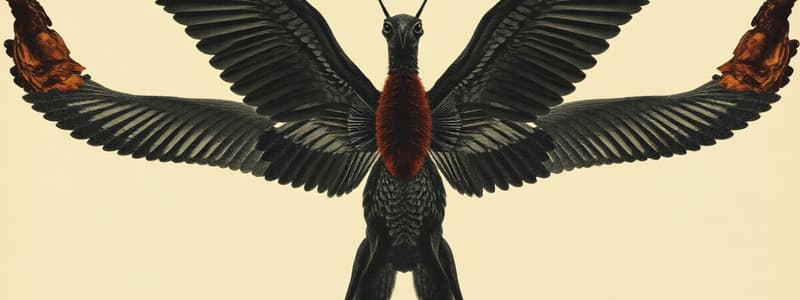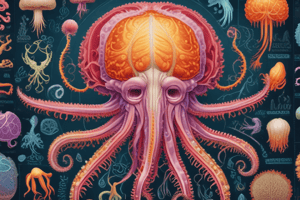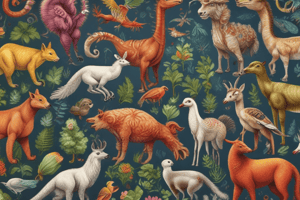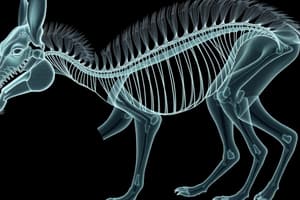Podcast
Questions and Answers
What key feature distinguishes Gnathostomata from Agnatha?
What key feature distinguishes Gnathostomata from Agnatha?
- Development of a vertebral column
- Ability to live in various habitats
- Presence of jointed limbs
- Possession of jaws (correct)
Which of the following features is NOT found in Amphioxus?
Which of the following features is NOT found in Amphioxus?
- Gills/lungs (correct)
- Heart (correct)
- Segmentation
- Well-developed brain (correct)
Which group of vertebrates is known for having an amniotic egg?
Which group of vertebrates is known for having an amniotic egg?
- Agnatha
- Tetrapoda (correct)
- Cephalochordata
- Gnathostomata
What evolutionary advantage do jaws provide to Gnathostomata?
What evolutionary advantage do jaws provide to Gnathostomata?
Which of the following statements about vertebrate origins is true?
Which of the following statements about vertebrate origins is true?
What is a common feature shared by both vertebrates and arthropods?
What is a common feature shared by both vertebrates and arthropods?
Which characteristic is most associated with extreme cephalization in vertebrates?
Which characteristic is most associated with extreme cephalization in vertebrates?
Which group of vertebrates is best adapted for life on land?
Which group of vertebrates is best adapted for life on land?
What is a defining characteristic of the phylum Porifera?
What is a defining characteristic of the phylum Porifera?
Which of the following organisms belongs to the phylum Cnidaria?
Which of the following organisms belongs to the phylum Cnidaria?
What type of symmetry is typically associated with organisms in the Eumetazoa group?
What type of symmetry is typically associated with organisms in the Eumetazoa group?
What are the two primary layers of cells in diploblastic organisms?
What are the two primary layers of cells in diploblastic organisms?
Which of the following themes is significant in the study of animal relationships?
Which of the following themes is significant in the study of animal relationships?
What distinguishes Eumetazoa from Porifera in terms of tissue organization?
What distinguishes Eumetazoa from Porifera in terms of tissue organization?
During gastrulation in diploblastic organisms, which cell layer forms the inside of the body?
During gastrulation in diploblastic organisms, which cell layer forms the inside of the body?
What aspect of cnidarians contributes to their mobility?
What aspect of cnidarians contributes to their mobility?
What type of symmetry is characterized by not being very directional?
What type of symmetry is characterized by not being very directional?
Which of the following groups is part of the Bilaterian classification?
Which of the following groups is part of the Bilaterian classification?
What does the term 'cephalization' refer to in bilateral organisms?
What does the term 'cephalization' refer to in bilateral organisms?
Which characteristic is NOT typically associated with chordates?
Which characteristic is NOT typically associated with chordates?
What is one example of a deuterostome?
What is one example of a deuterostome?
What is significant about the Cambrian 'Explosion' in relation to animal evolution?
What is significant about the Cambrian 'Explosion' in relation to animal evolution?
Which of these is NOT a function of pharyngeal slits in chordates?
Which of these is NOT a function of pharyngeal slits in chordates?
Which group is considered a lophotrochozoan?
Which group is considered a lophotrochozoan?
What is one of the key features that allows amniotes to be more successful on land than amphibians?
What is one of the key features that allows amniotes to be more successful on land than amphibians?
Which of the following is NOT a function of the amniotic egg?
Which of the following is NOT a function of the amniotic egg?
Which group of animals is known to have dry scaly skin to reduce water loss?
Which group of animals is known to have dry scaly skin to reduce water loss?
What characteristic does not describe the evolutionary adaptations of birds and mammals?
What characteristic does not describe the evolutionary adaptations of birds and mammals?
Which of the following types of animals evolved a 4-chamber heart?
Which of the following types of animals evolved a 4-chamber heart?
What is a notable feature of Archaeopteryx?
What is a notable feature of Archaeopteryx?
Which feature is shared by both birds and mammals as an adaptation for high metabolic rates?
Which feature is shared by both birds and mammals as an adaptation for high metabolic rates?
Which of the following statements about reptiles is true?
Which of the following statements about reptiles is true?
Flashcards
Animalia Kingdom
Animalia Kingdom
Multicellular, eukaryotic, and heterotrophic organisms.
Porifera
Porifera
Sponges; early animals with no true tissues or many cell types.
Eumetazoa
Eumetazoa
Animals with true tissues, two cell layers, endoderm, and ectoderm.
Cnidaria
Cnidaria
Signup and view all the flashcards
Diploblastic animals
Diploblastic animals
Signup and view all the flashcards
Heterotrophic
Heterotrophic
Signup and view all the flashcards
Nervous System in Cnidarians
Nervous System in Cnidarians
Signup and view all the flashcards
Gastrulation
Gastrulation
Signup and view all the flashcards
Chordate Evolution
Chordate Evolution
Signup and view all the flashcards
Vertebrate Origins
Vertebrate Origins
Signup and view all the flashcards
Amphioxus
Amphioxus
Signup and view all the flashcards
Vertebrate Sense Organs
Vertebrate Sense Organs
Signup and view all the flashcards
Jointed Skeleton
Jointed Skeleton
Signup and view all the flashcards
Extreme Cephalization
Extreme Cephalization
Signup and view all the flashcards
Gnathostomata
Gnathostomata
Signup and view all the flashcards
Tetrapoda
Tetrapoda
Signup and view all the flashcards
Radially Symmetrical
Radially Symmetrical
Signup and view all the flashcards
Bilateral Symmetry
Bilateral Symmetry
Signup and view all the flashcards
Cephalization
Cephalization
Signup and view all the flashcards
Protostomes
Protostomes
Signup and view all the flashcards
Deuterostomes
Deuterostomes
Signup and view all the flashcards
Notochord
Notochord
Signup and view all the flashcards
Dorsal Hollow Nerve Cord
Dorsal Hollow Nerve Cord
Signup and view all the flashcards
Pharyngeal Slits
Pharyngeal Slits
Signup and view all the flashcards
Amphibian Reproduction
Amphibian Reproduction
Signup and view all the flashcards
Amniotic Egg
Amniotic Egg
Signup and view all the flashcards
Amniote Success
Amniote Success
Signup and view all the flashcards
Reptiles
Reptiles
Signup and view all the flashcards
Paraphyletic Group
Paraphyletic Group
Signup and view all the flashcards
Birds and Mammals
Birds and Mammals
Signup and view all the flashcards
Archaeopteryx
Archaeopteryx
Signup and view all the flashcards
Mammalian Origin
Mammalian Origin
Signup and view all the flashcards
Study Notes
Animal Relationships
- Metazoa = Animalia, Eumetazoa, and Bilateria are major animal groups
- Themes include mobility and the colonization of land
- Kingdom Animalia is multicellular, eukaryotic, and heterotrophic
Porifera - Early Animals
- Lack true tissues
- Few cell types
- Some cells are totipotent (can differentiate into other cell types)
- Filter feeders with numerous pores/holes
- Water current is created by choanocytes (cells with flagella)
- Similar to choanoflagellates
Eumetazoa
- Diploblastic - two cell layers (endoderm and ectoderm)
- Examples include cnidarians (jellyfish, anemones, corals)
Bilateria - Origins and Diversification
- Cambrian "explosion" - many modern animal phyla appeared within a relatively short period (40 million years)
Bilateral Symmetry and Cephalization
- Cephalization - sense organs clustered at the anterior (front) end
- Bilateral symmetry - body parts are arranged in pairs on either side of a central axis
Two Great Branches of the Bilaterian Tree
- Protostomes (e.g., annelids, arthropods, mollusks)
- Deuterostomes (e.g., chordates)
Chordate Characteristics
- Notochord (structural support)
- Dorsal hollow nerve cord
- Pharyngeal slits (feeding and respiration)
- Muscular tail
Chordates and Activity Level
- Early chordates had relatively low metabolisms
- Subsequent chordates evolved a higher metabolic rate
- Parallels exist between protostome and chordate development
Vertebrate Origins and Relationships
- Vertebrates share a common ancestry with Amphioxus (a cephalochordate)
- Key characteristics include great sense organs (eyes, nose, hearing); a jointed skeleton; vertebral column; extreme cephalization
- Gnathostomata have jaws (includes "Fishes," Amphibians, Amniotes)
- Amniotes (Reptiles, Birds, and Mammals) have eggs with protective membranes (amniotic eggs)
"Agnatha"
- These vertebrates lack jaws
- Evolved gill arches that support more effective feeding
- Higher metabolic rate
Sharks and Bony Fishes
- Extremely successful in water
- Wide range of habitats occupied
- No major land invasions
Tetrapods
- Amphibians, Reptiles, Birds, and Mammals
- Successful on land, jointed appendages allowing more efficient movement
- Amphibians still rely on water for reproduction
- Amniotes (Reptiles, Birds, and Mammals) have evolved to be much more successful on land
Amniotes
- Eggs that can survive on land
- Amnion surrounds the embryo, protecting it from drying out
- Other critical components include the yolk sac, allantois, and chorion
- Reptiles are paraphyletic (do not form a monophyletic group)
Birds and Mammals
- Evolved high metabolic rates independently
- Features such as insulation, efficient locomotion and respiration, complex hearts, and high body temperatures are key
Flight Adaptations of Birds
- Feathers
- Archaeopteryx
- Teeth
- Claws
- Long, bony tail
Studying That Suits You
Use AI to generate personalized quizzes and flashcards to suit your learning preferences.




